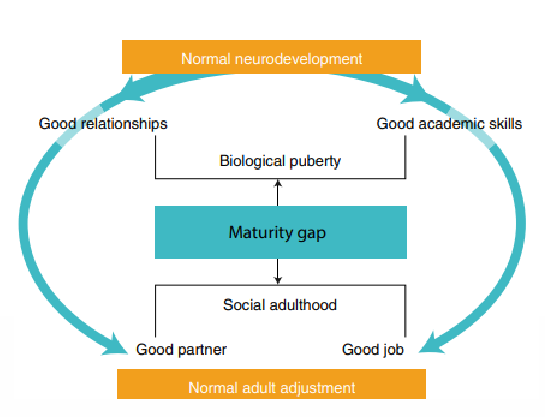Lecture 8 - Social cognition and Moral development
1/67
There's no tags or description
Looks like no tags are added yet.
Name | Mastery | Learn | Test | Matching | Spaced |
|---|
No study sessions yet.
68 Terms
What does the dilemma of Heinz entail?
Should Heinz break into the druggist’s laboratory and steal the medicine for his ill wife?
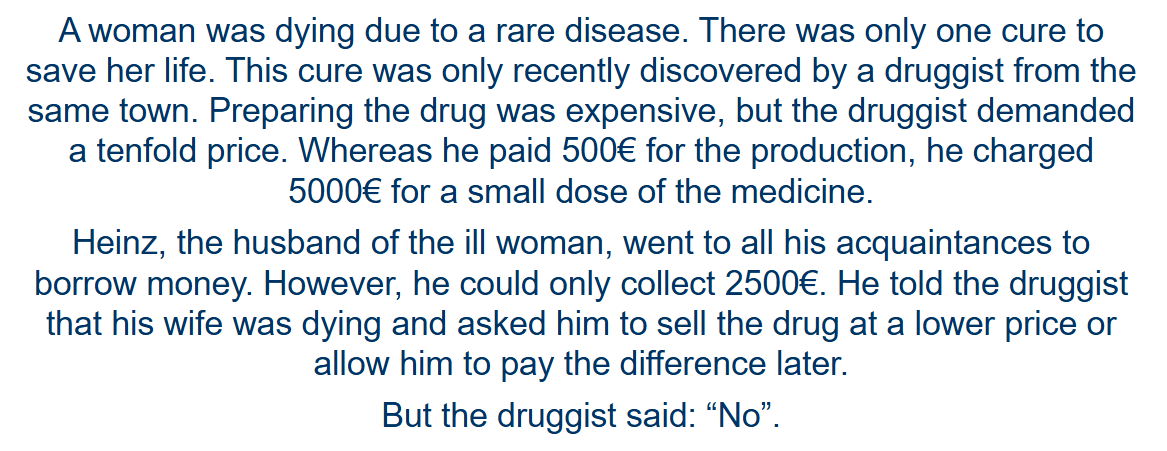
What are the 3 stages and 6 substages in Kohlberg’s Moral stages?
Preconventional level: Person operates according to a “Will I be punished or rewarded” mentality (typical for age 13).
Stage 1: Punishment and Obedience Orientation: “Heinz cannot steal the drug because then he will go to prison.”
Heteronomous morality
Stage 2: Self-interest Orientation: “Heinz should steal the drug because his wife will love him more.”
Homo calculus economics
Conventional stage: Person’s morality centers on the need to obey society’s rules (most 15/16 year-olds and most adults).
Stage 3: Good interpersonal relationships: “Heinz has to steal the drug because that’s what a good husband does.”
Approval / honor
Stage 4: Maintaining the social order: “Heinz cannot steal the drug because then other people would also steal and the laws would break down.”
Law and order
Postconventional stage: Person has a moral code that transcends society’s rules (few people achieve this level).
Stage 5: Social contract and Individual rights: “Heinz cannot steal the drug because a scientist has the right to be rewarded for his work, which would be undermined by the theft.
Utilitarianism + Basic rights
Stage 6: Universal principles: “Heinz has to steal because the value of a human life is more fundamental than the property rights of another individual.”
Kantian morality
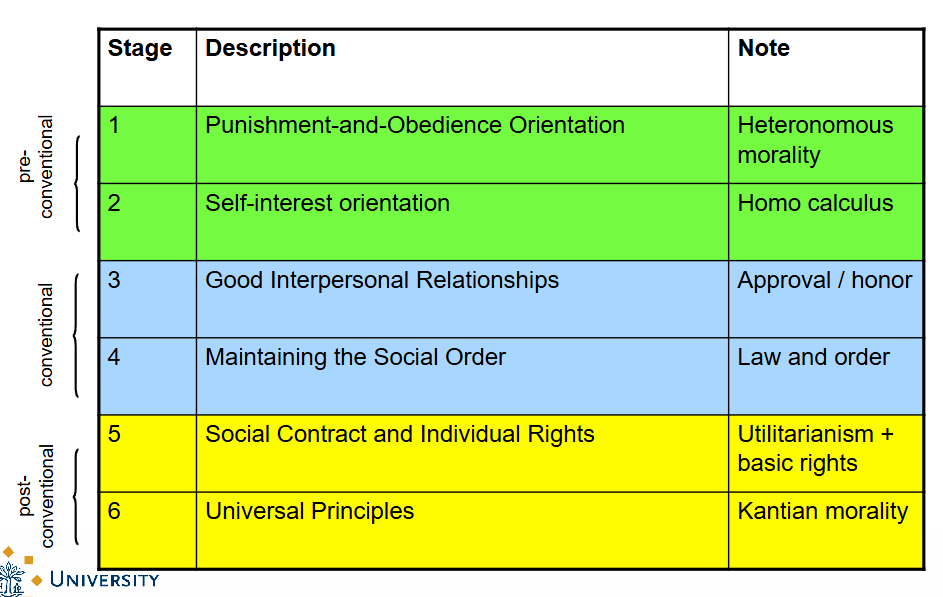
“Heinz cannot steal the drug because then he will go to prison.”
What Stage of Kohlberg’s moral stages does this person belong?
Preconventional stage — Stage 1: Punishment-and-Obedience Orientation.
Heteronomous morality.
Typical for age 13.
“Heinz should steal the drug because his wife will love him more.”
What Stage of Kohlberg’s moral stages does this person belong?
Preconventional stage — Stage 2: Self-interest orientation.
Homo calculus / economics.
Typical for age 13.
“Heinz has to steal the drug because that’s what a good husband does.”
What Stage of Kohlberg’s moral stages does this person belong?
Conventional stage — Stage 3: Good interpersonal relationships.
Approval / honor.
Most 15/16 year olds and most adults.
“Heinz cannot steal the drug because then other people would also steal and the laws would break down.”
What Stage of Kohlberg’s moral stages does this person belong?
Conventional stage — Stage 4: Maintaining the Social order.
Law and order.
Most 15/16 year olds and most adults.
“Heinz cannot steal the drug because a scientist has the right to be rewarded for his work, which would be undermined by the theft.”
What Stage of Kohlberg’s moral stages does this person belong?
Post-conventional stage — Stage 5: Social contract and Individual rights.
Utilitarianism + Basic rights.
Few people achieve this level.
“Heinz has to steal the drug because the value of a human life is more fundamental than the property rights of another individual.”
What Stage of Kohlberg’s moral stages does this person belong?
Post-conventional stage — Stage 6: Universal principles.
Kantian morality.
Few people achieve this level.
What are 3 Evidences on the Stage idea of Kohlberg’s theory?
• Children can go beyond a punishment-and-reward mentality
• No clear transitions between discrete stages; going back and forth and skipping stages is common
• Stages 3/4 (conventional) remains dominant (only 10% score higher, very few stage 6)
What are the 4 points regarding Validity of Kohlberg’s theory?
• Moderate association between moral cognition and moral behavior
• Lack of control for confounds (intelligence, personality, etc.)
• Association is moderated by motivation and self-control
• But: Teenagers are famous for questioning society’s rules, for seeing the world’s injustice, and for getting involved in idealistic causes
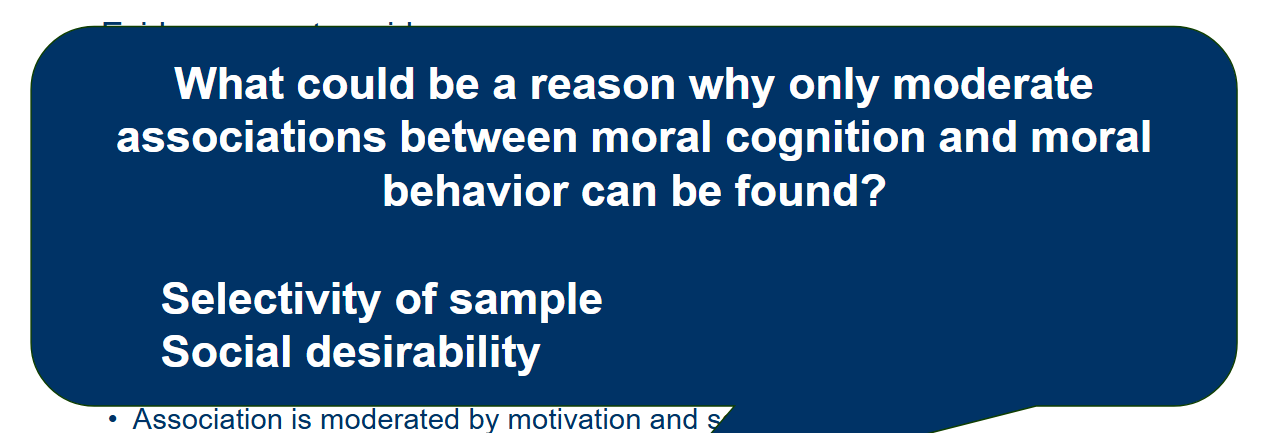

What are 2 Alternative theoretical explanations of Moral development?
Social learning theory (Bandura)
Evolutionary theory (Krebs, Tomasello)
How does the Social learning theory of Bandura explain Moral development?
Moral behavior is affected by:
Observational learning
Reinforcement
Self-regulation processes
Moral disengagement
Situational influences
How does the Evolutionary theory of Krebs, Tomasello explain Moral development?
Humans have evolved not only to be aggressive on occasion but to have moral and prosocial tendencies that equip them to live cooperatively in groups.
What is Theory of Mind (TOM)?
Ability to form ideas (theories) about the mental world of yourself and of others and to explain behavior in terms of mental states (intentions, desires, expectations).
What is TOM the basis for? Name 5 things.
• Social relationships, including popularity & friendships
• Empathy (sharing, helping)
• Reciprocal conversation
• Humor
• Ability to lie
→ Important milestone
The first social cognitive skills begin to form in Infancy, what are 6 things that develop, leading to the TOM?
Understanding intentions
Joint attention
Pretend play
Imitation
Emotional understanding
Desire psychology
What does the Research of Hamlin (2007) about the (social) cognition of babies entail?
Baby’s 6-10 months have a ‘moral compass’.
→ Preference for ‘helping’ triangle compared to ‘annoying’ square.

What is the Classic debate in baby (and primate) research regarding social cognition of babies?
▪ Does observed behavior indicate a deeper understanding or is it a
matter of simple associative learning?
▪ Simple association: when reaching top: bouncing = fun → baby prefers
triangle?
▪ Indeed: square + bouncing circle → baby prefers square
▪ But: triangle with goal-directed gaze (looking at top of hill) + no bounce
→ baby prefers triangle
➢Importance and understanding of eye gaze as sign of intentionality
What is Joint attention?
Joint attention = shared attention
▪ Around 1 year: important developmental milestone
▪ Follow pointing hand / gaze (respond to/initiate)
▪ Building block for shared knowledge and shared experiences!
▪ If it develops very late or not at all: Possible sign of developmental
disorder: autism spectrum disorder
What is Pretend play? What age does it emerge?
Distinguishing between pretense (a kind of false belief) and reality.
First simple pretend play between 1 and 2 years.
What is Imitation? When is it observed?
Ability to mentally represent others’ actions + goals.
In first year.
What is Emotional understanding? What age does this develop?
Understanding that other people have emotions and that these emotions can be influenced for bad or good.
In 2nd year.
What is Desire psychology? When does this develop?
Around age 2: Express what they want, explain own behavior and that of others in terms of wants or desires.
When does Belief-desire psychology develop? What does it entail?
By age 3 to 4 years; Understanding that beliefs, true or false, guide people’s behavior just as desires do.
What is the False belief test (Sally Anne test)?
Classic TOM test.
Questions:
• Where does Sally search for the ball? (belief)
• Where is the ball? (reality check)
• Where was the ball in the beginning? (memory check)
If children answer the basket = sign of TOM.
If children pass the false belief test, they understand that people act upon their beliefs about the world rather than an objective reality.
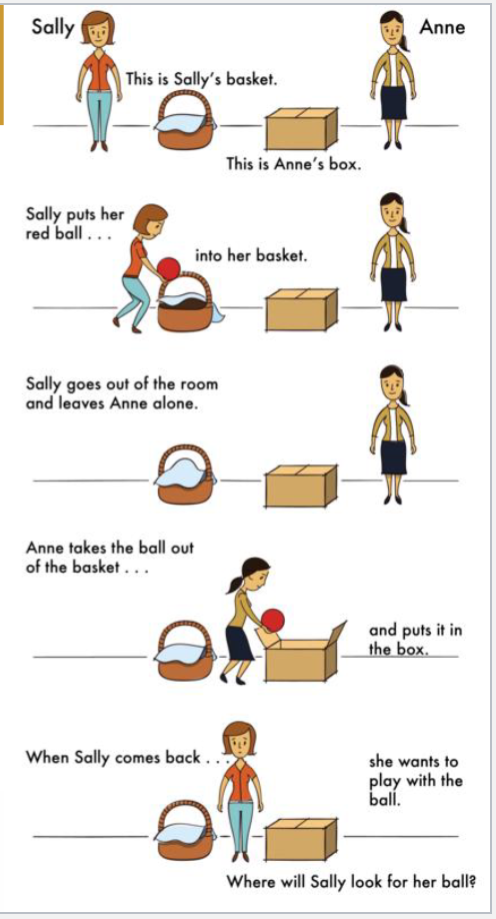
What are 2 criticisms on the False belief test?
• You need more than theory of mind to pass false belief test
Language, executive functions (inhibition, working memory)
• Theory of mind is more than passing a false belief test
Theory of mind grows more sophisticated, better understanding of more complex psychological processes
Understanding false beliefs is NOT an ‘end point’, but just the beginning
In which stage of Piaget can children take others’ perspectives?
In the preoperational phase (counter to what Piaget thought).
What are the 2 types of TOM that children show?
Explicit TOM: Sally-Anne test (need verbal skills, explicit questions).
Implicit TOM tests: Implicit cues (where do you look at).
Children of 15 months even show implicit TOM.
What are the developmental stages and age of Social cognitive abilities?
Age 5-7 years of age:
Better understanding that people’s behaviors do not necessarily reflect their thoughts and feelings.
Late elementary school:
Mastering of complex second-order belief statements.
Schoolchildren:
Have to learn to understand sarcasm.
Middle and late childhood:
Understanding that beliefs can be false to realizing that the same event can be open to multiple interpretations.
Social cognitive skills continue to improve after adolescence.
What is a difference regarding Social cognitive abilities and Nonsocial cognitive skills?
Social cognitive abilities are better maintained during adulthood than nonsocial cognitive skills.
In older age, social cognitive performance improves further: taking multiple perspectives and seeing possibilities for compromise
People use social cognitive abilities every day and accumulate expertise
→ Highest skills in socially active and involved older adults in meaningful social roles
What does decline in social cognitive tasks look like and what is one cause of this decline?
e.g. understanding sarcasm less and passing adult versions of theory-of-mind tasks.
Especially likely if tasks overload basic cognitive abilities by requiring fast information processing or high levels of executive control.
What are the 2 types of Empathy and their differences?=

What does development of empathy in newborns look like?
• Newborn baby: emotional contagion
Emotional contagion also in adults (ex. yawning when others are yawning).
• First year: Early tendency to imitate emotional expressions
• Basic aspect of affective empathy
• No clear distinction between one’s own and other’s
emotional states.
How can empathic concern be observed in the first year?
Looking longer at someone who is hurt.
Worried facial expression.
What ability is crucial for showing empathic concern?
The ability to make a distinction between self and other.
When is the development of empathy most notable?
Between 1 and 2 years.
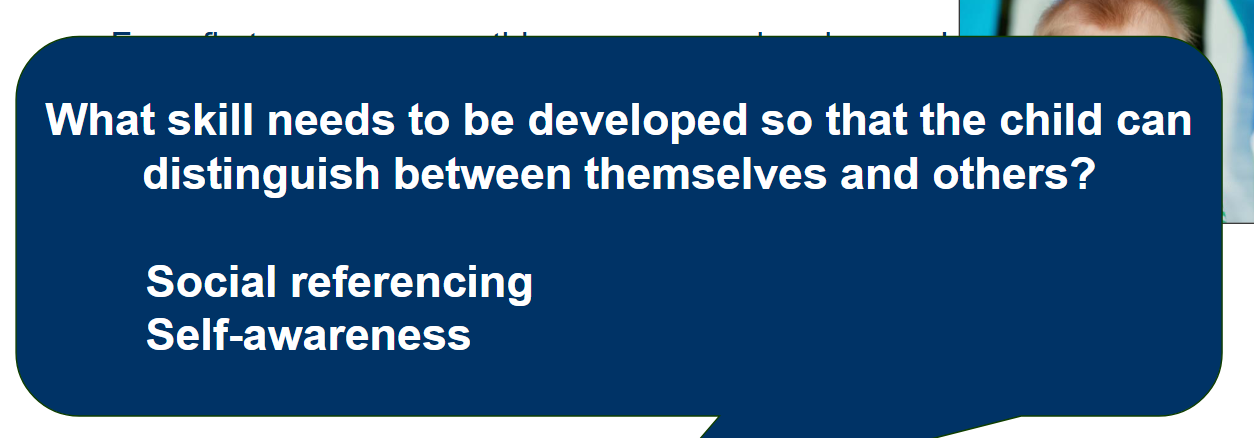
Self-awareness.
What do children show in their development of empathy regarding Prosocial behavior?
Instrumental helping
Empathetic helping
Girls tend to show more prosocial behavior — more rewarded? BUT there are individual differences.
When does Instrumental helping show? What does it mean?
12-14 m; Helping with a goal-directed action.
ex. Picking up an object out of reach of the other perosn.
When does Empathetic helping show? What does it mean?
18-24m; Prosocial response to someone’s sadness or pain.
e.g. comforting behavior.
Children struggle helping if… name 3 things.
▪ ...Child needs to reflect on other’s emotional state (vs instrumental helping)
▪ ...Child must give up something to help the other
▪ ...Other person gives few/subtle cues of what is needed
What is the association between Cognitive and Social development?
• Prosocial behavior occurs more often in Piaget’s concrete operational phase (children understand what is needed to help)
• Prosocial behavior as a product of theory of mind development
What does development of prosocial behavior in childhood look like?
• Middle childhood: prosocial behavior requires information-
processing skills
• School children also tailor their prosocial behavior to whether
they can effectively offer aid..
...whereas preoperational preschoolers may offer their blankie
Middle childhood: What skills does prosocial behavior require?
Information-processing skills.
There are individual differences (relatively stable) in prosocial behavior, but there are also gender and cultural differences. What are those?
Gender differences:
• Girls more likely to comfort bullied child
• Boys more likely to stand up to a bully
• Only small differences for sharing
Cultural differences in modesty:
• Japanese children more modest about prosocial behavior
• Dutch children are more likely to expect compliment
What is Aggression? What development is aggression associated with?
Causing (physical/emotional) pain in others.
Associated with motor and cognitive development.
What are the 2 types of aggression based on Motive for behavior?
Reactive (impulsive) aggression: Direct response to threat/frustration, not well thought through.
Jimmy took my toy, so I’m going to hit him!
Proactive (instrumental) aggression: With intent to reach a goal.
I’ll hit Tommy so I can get his toys.
What are the 2 types of Aggression based on Differences in form? When do they develop?
Direct aggression: directly visible aggression
e.g., calling names into someone’s face, punching others
Most occuring form: physical aggression
Peeks around 2.5 years, declines in middle childhood
Indirect aggression: not directly visible aggression
e.g., calling names behind their back, not inviting another kid to a birthday party, spreading rumors..
Most occuring form: relational aggression = aggression directed at harming social relations / social status
Involves more sophisticated social skills
Peeks around (start of) adolescence
What is Relational aggression?
Aggression directed at harming social relations / social status.
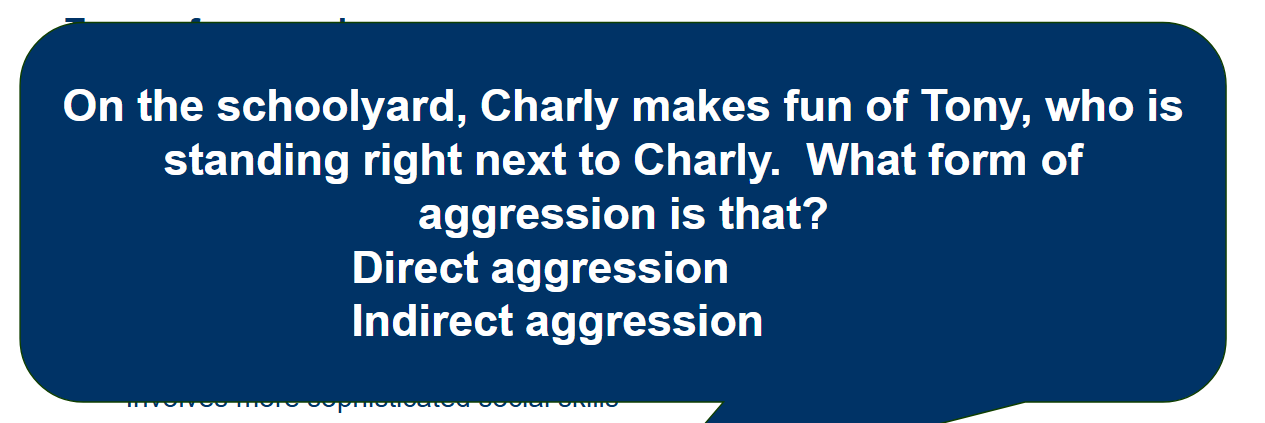
Direct aggression.
What are the Gender differences in Aggressive behavior?
• Boys show more physical aggression
• Both boys and girls show verbal and relational aggression
Overt physical aggression is severely sanctioned in females, so girls make relational aggression their major mode
BUT: teenage boys as relationally aggressive as teenage girls
• Impact of relational aggression bigger for girls
What happens in early adolescence regarding Antisocial and risk behavior?
Crime increases dramatically.
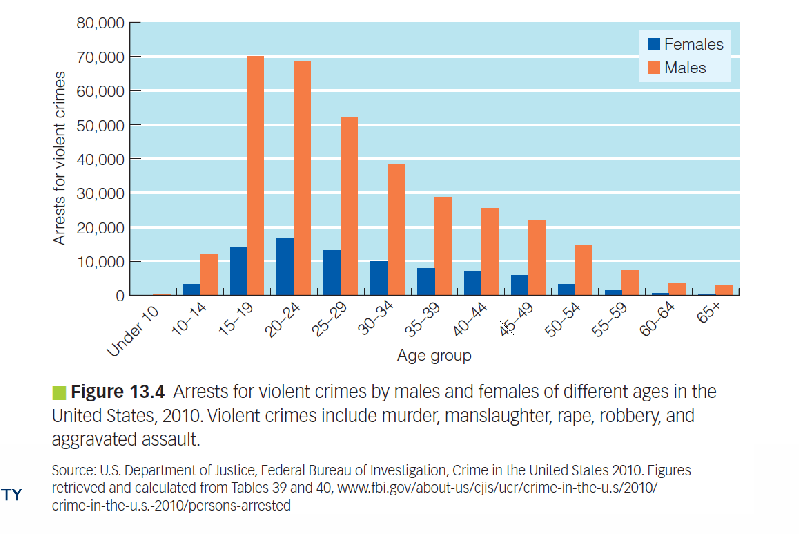
What are 4 Factors explaining Juvenile delinquency.
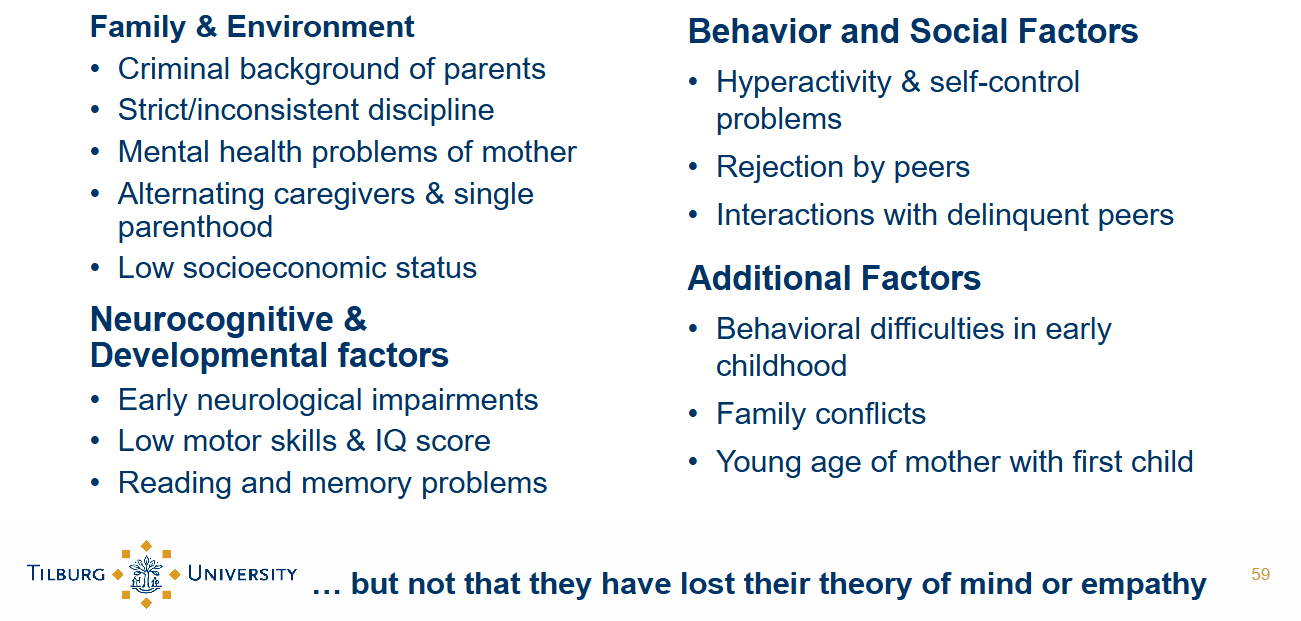
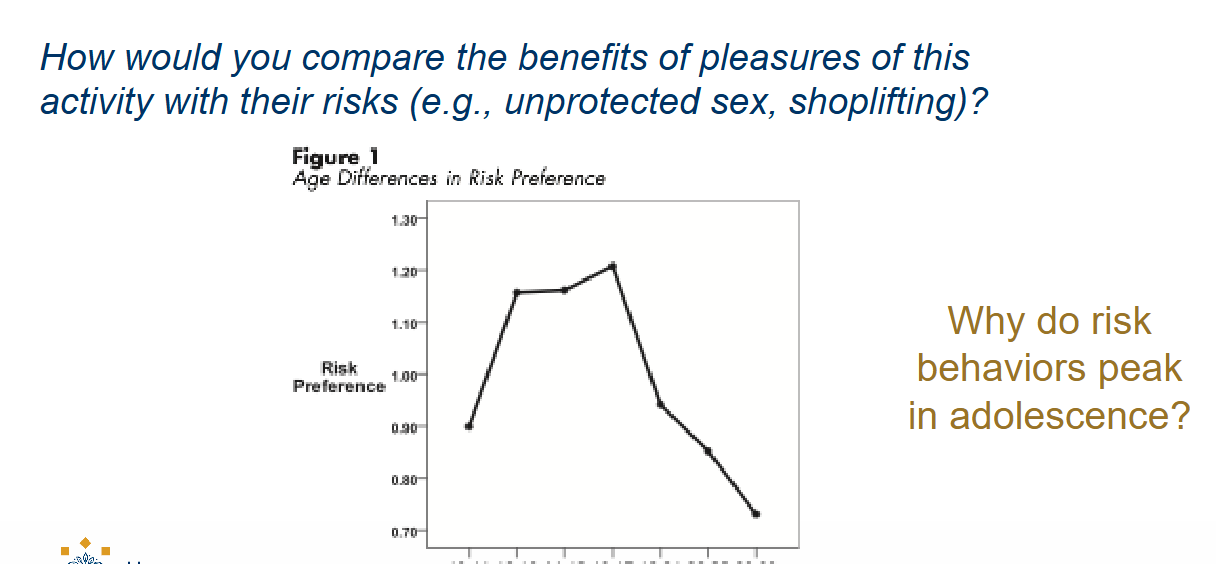
What are the 2 types of antisocial behavior according to Moffitt’s theory?
1. Early-onset (life-course persistent)
small minority of male population (ca. 5%), often with neuro-cognitive deficits
high long-term stability (recidivism)
growing up in difficult families and neighborhoods
2. Late-onset (adolescence-limited)
majority of adolescents demonstrates anti-social behavior (normative!), disappears after puberty
appear to imitate the life-course persistent category
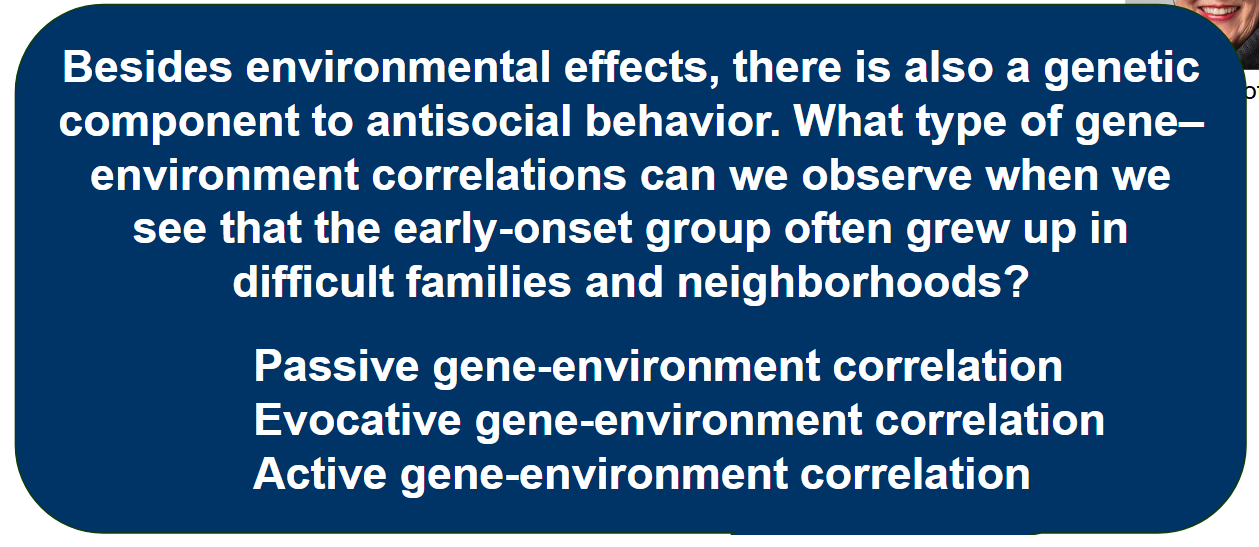
Evocative gene-environment correlation?
What are the differences between Early-onset vs. Late-onset group?
Same behavior, but different motivations.
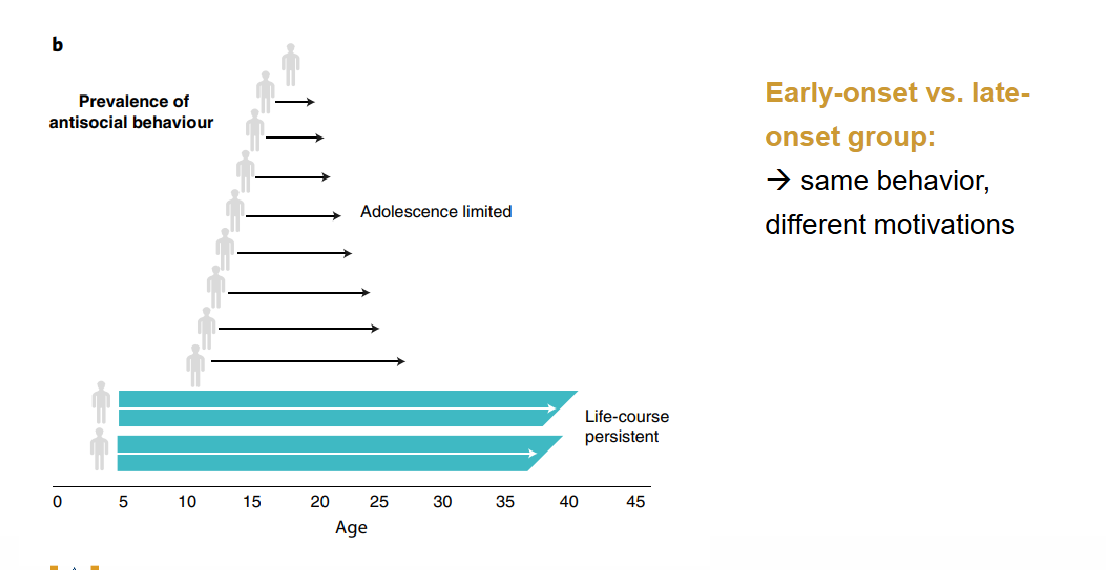
What are the Risk factors for Early-onset vs. Late-onset group?
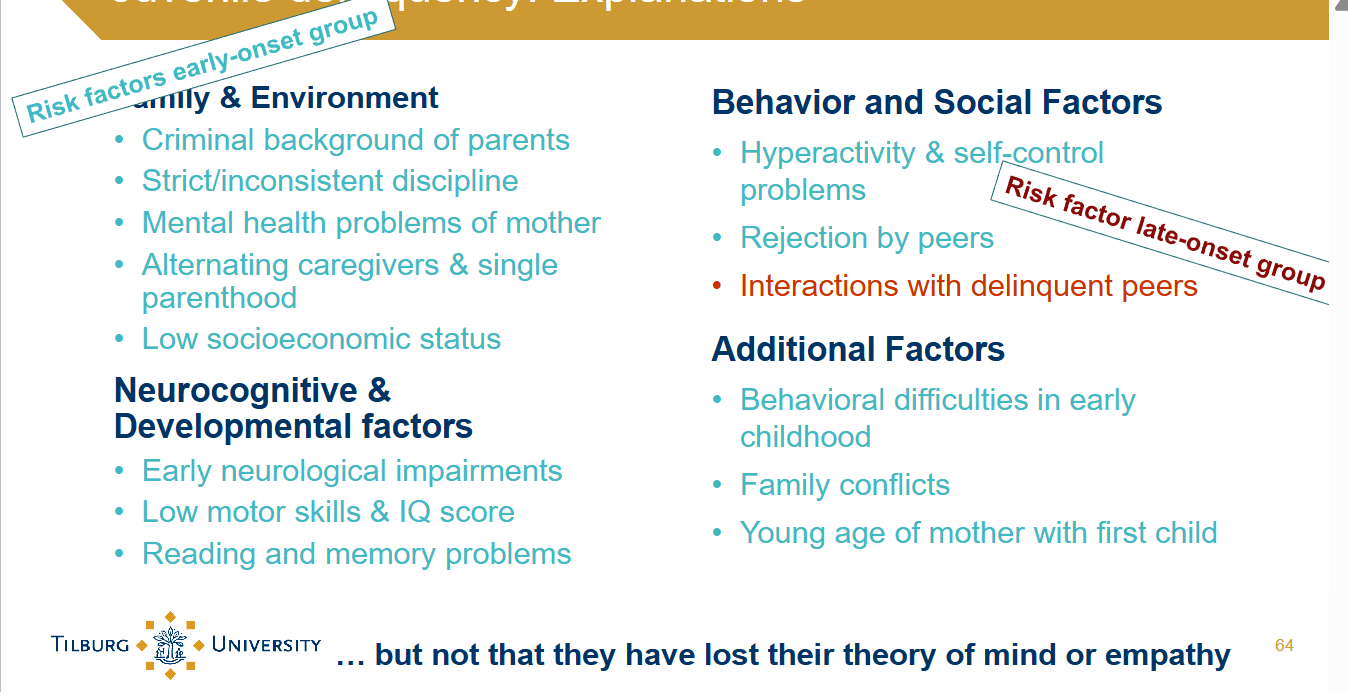
What is the Vicious circle for Early-onset group?
Evocative??
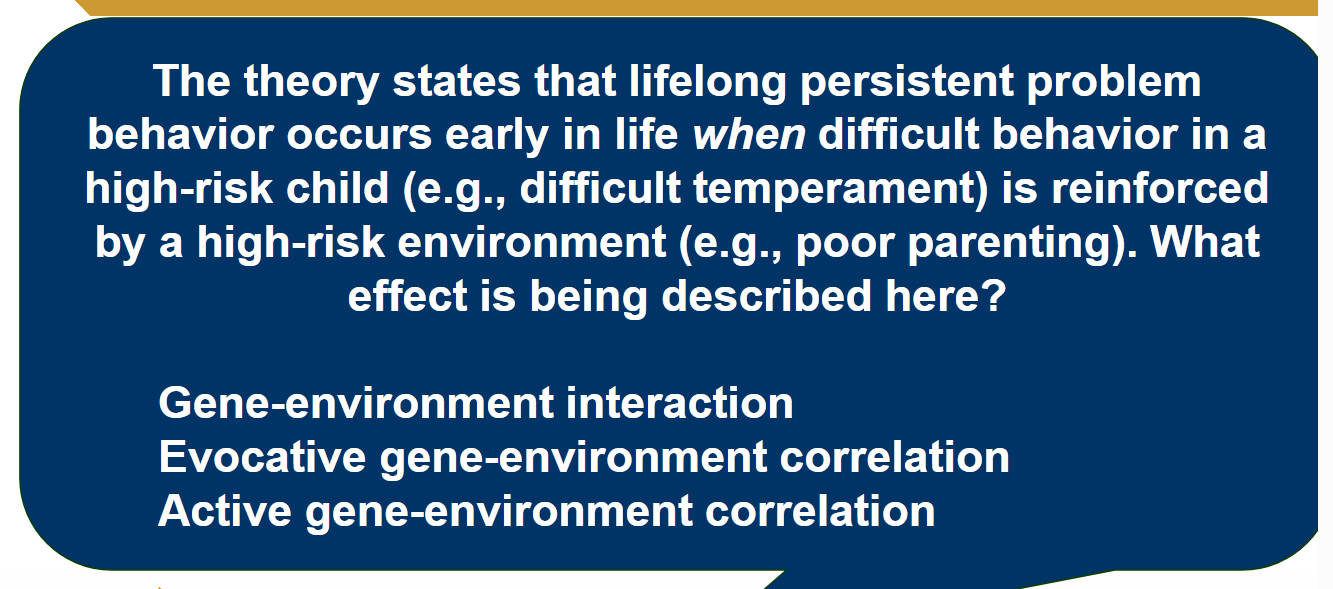
What is an explanation for the Antisocial and risk behaviors?
Why do adolescents in the late-onset group copy deviant behavior of the early-onset group?
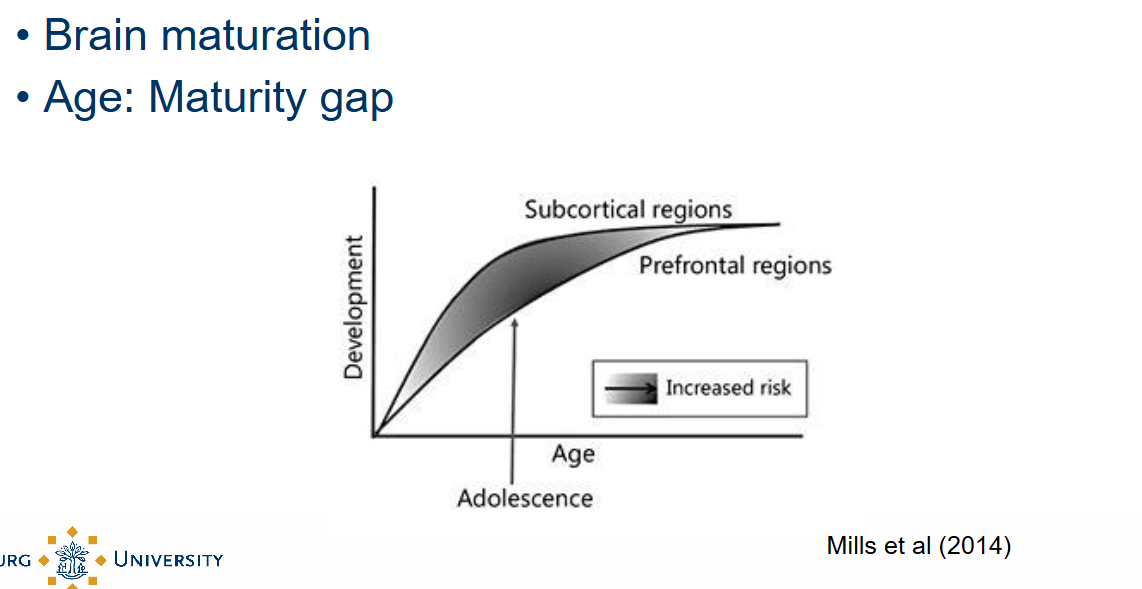
How might Brain development in adolescence explain Antisocial and risk behavior?
• Increase in levels of neurotransmitters, particularly dopamine
→ Increased risk taking
→ Increased reward seeking
• Brain is still growing
Limbic system: almost completely developed in early adolescence
Prefrontal cortex: maturation not finished until adults years (18-25 years)
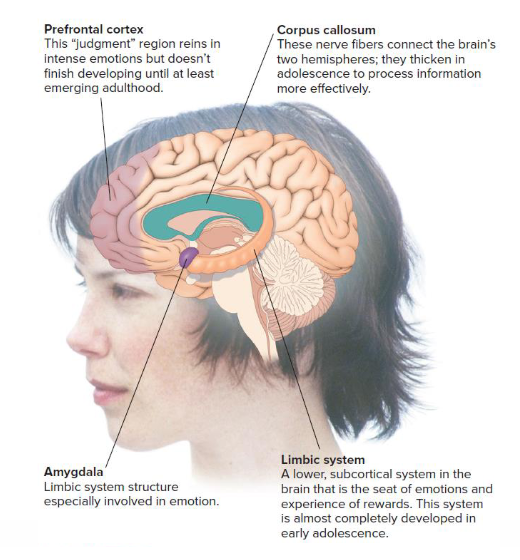
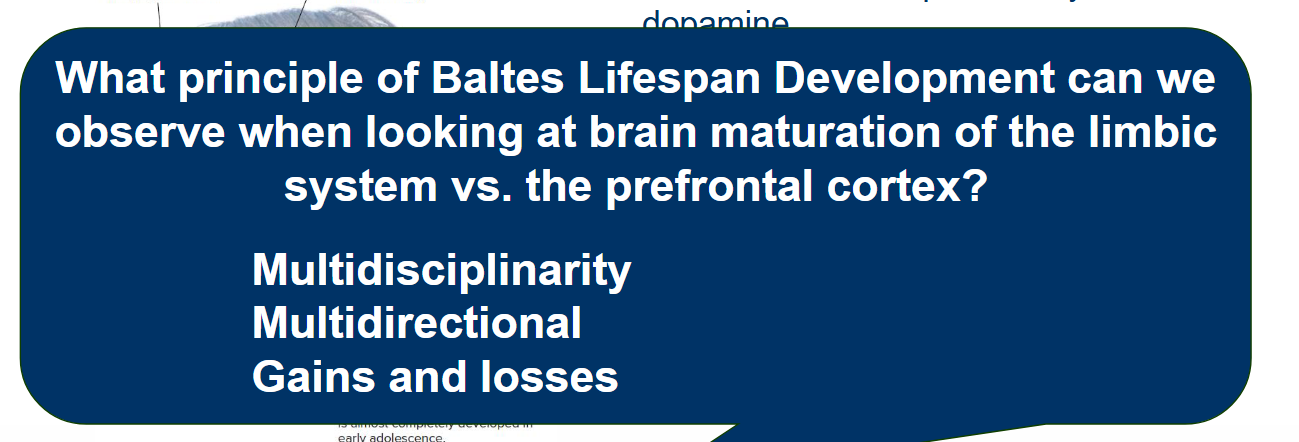
What does the Iowa task Gambling entail?
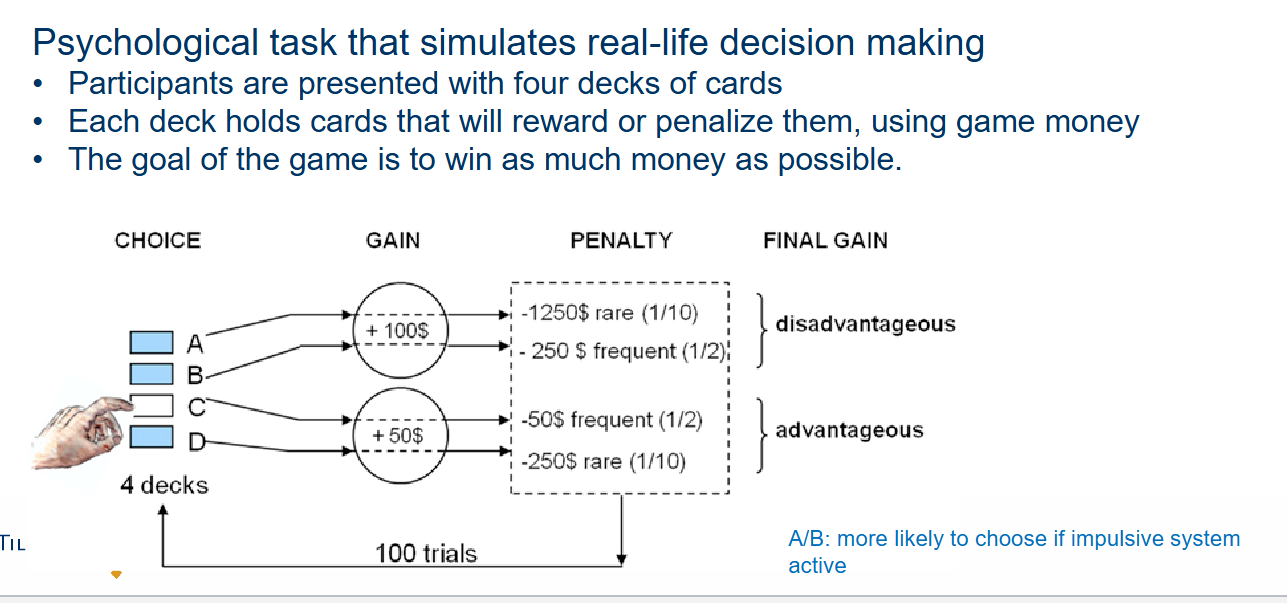
What does Antisocial and risk behavior look like in the Brain?
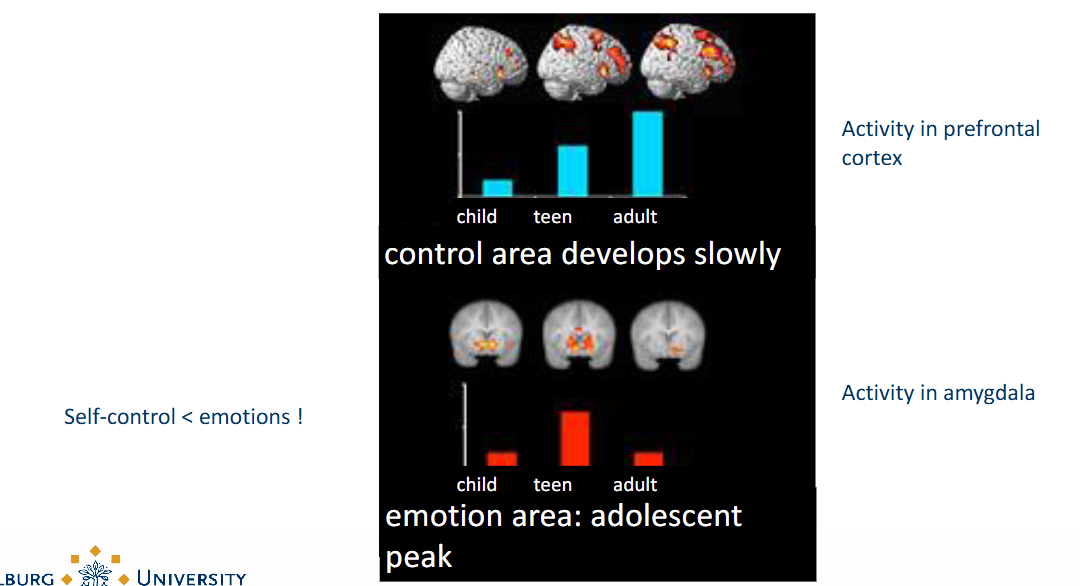
How does Age: Maturity gap explain Antisocial and risk behavior?
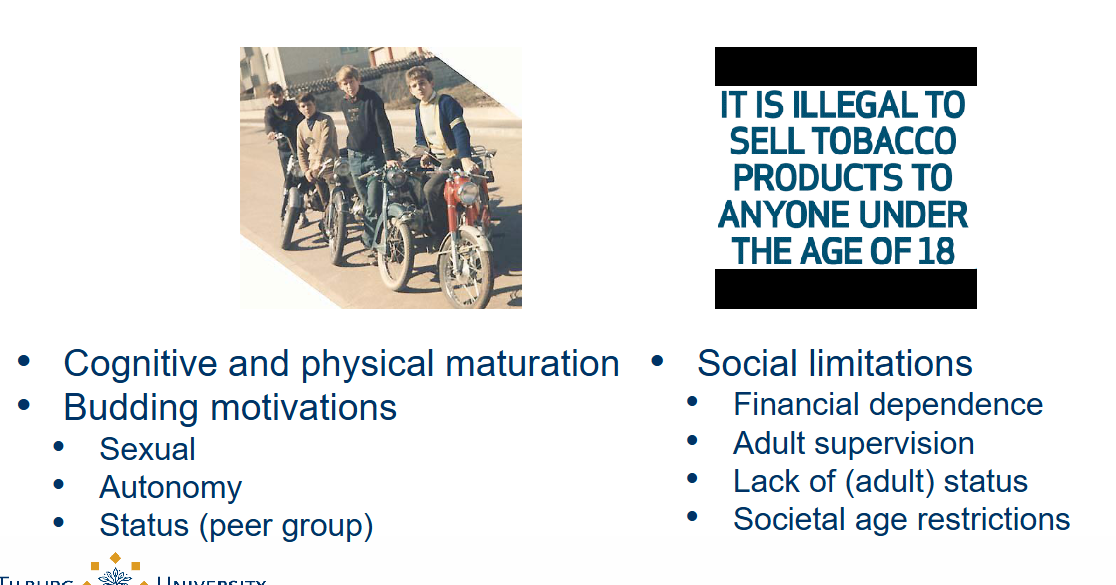
Not every adult demonstrates risk behavior (suggested by a biological perspective); Risk behavior is not necessarily an error in calculation; it can also be functional. Name 3 functional reasons.
1. individuation (distancing from parents)
2. experimenting (learning by doing)
3. bonding with peers (e.g., during study)
